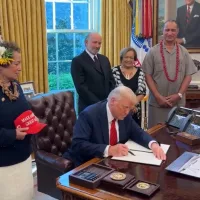
ASG has moved to clarify key facts, address misconceptions and explain the local significance of the reopening of certain U.S. Pacific fishing grounds.
It issued a press release with information based on “a comprehensive presentation “ prepared by Taotasi Archie Soliai, Executive Advisor for Natural Resources, following his recent visit to Washington, D.C., where he met with President Donald J. Trump and joined Congresswoman Aumua Amata to advocate for the interests of American Samoa’s vital fisheries industry.
The Pacific Remote Islands Marine National Monument (PRIMNM) was established in 2009 under President George W. Bush.
In 2014, President Barack Obama expanded the monument, prohibiting commercial fishing across nearly 500,000 square miles of U.S. waters.
In 2025, President Donald J. Trump issued a proclamation reopening these waters to U.S-flagged commercial fishing vessels.
Although these areas are outside of American Samoa’s Exclusive Economic Zone (EEZ), the decision carries major economic implications for the territory’s tuna industry and long-term economic sustainability, says the press release.
The tuna industry supports over 83% of private-sector jobs in American Samoa.
It accounts for 99% of local exports. StarKist Samoa processes more than 100,000 tons of tuna annually, producing over 500 million cans of shelf-stable tuna—primarily for the U.S. market. 1 in 4 cans of shelf-stable tuna sold in the U.S. originates from American Samoa.
“This is not just a policy issue—it’s a matter of economic survival for our people,” said Soliai. “We are advocating for fairness, sustainability, and opportunity.”
ASG emphasizes that the reopening of these fishing grounds does not eliminate existing environmental protections.
Fishing remains prohibited within 0 to 50 miles of the protected monument islands.
Coral reefs, marine mammals, seabirds, and turtles remain protected under federal laws.
U.S.-flagged fishing vessels must adhere to rigorous conservation standards under the Western and Central Pacific Fisheries Commission (WCPFC).
Scientific assessments confirm that tuna stocks in these waters are healthy and not overfished.
“There has been a lot of misinformation, but the reality is that environmental safeguards remain firmly in place, ” Soliai stated. “This is a measured decision, not a reckless one.”
ASG says reopening these fishing grounds is expected to:
- Support American Samoa’s workforce and economy
- Strengthen U.S. food security
- Ensure continued environmental stewardship and
- Maintain competitiveness of U.S. fishing fleets





